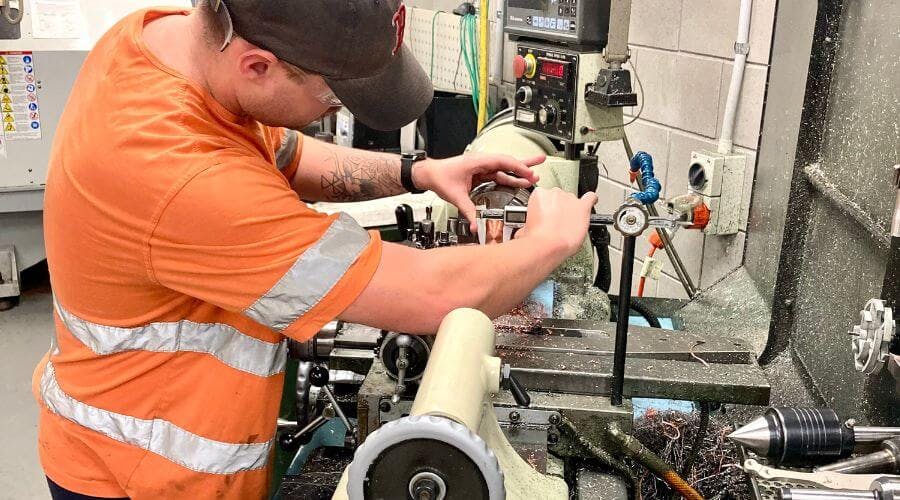Engineering Trade Apprenticeships: Comparing Fitter Specialisations

Jamie, a MIGAS Fitter and Turner Apprentice, taking measurements.
When thinking about pursuing an engineering trade apprenticeship, you might come across several roles within mechanical trade specialisations that seem quite similar.
Job titles like Mechanical Fitter, Fitter and Turner, and Fitter Machinist are often used interchangeably or involve some overlapping tasks. However, their specific meanings can vary depending on the context of the business or workshop.
In this article we break down the similarities and differences between these commonly sought-after engineering trades to assist in making an informed choice about which type of apprenticeship would suit you best.
Mechanical Fitter
Job Role: A mechanical fitter is typically responsible for assembling, installing, maintaining, and repairing mechanical systems, machinery, and equipment in various industries. They work with components such as gears, pumps, valves, and conveyors.
Duties: Mechanical fitters may perform tasks like fitting and aligning parts, troubleshooting mechanical issues, welding, and fabricating structures or components.
Skill Set: Mechanical fitters need a strong understanding of mechanical systems, blueprint reading, precision measurement, and the use of hand and power tools.
Learn more about Mechanical Fitter Apprenticeships
Fitter and Turner
Job Role: Fitting and turning are two distinct but closely related machining operations that essential in manufacturing and mechanical engineering for creating and assembling precision components and parts.
Duties: Fitters and turners perform tasks related to fitting components, as described for mechanical fitters, and turning operations on a lathe to create cylindrical or rounded parts. This dual skill set allows them to work on a wider range of projects.
Skill Set: They need proficiency in fitting and turning operations, precision machining, and the use of lathes and other machining equipment.
Learn more about Fitter and Turner Apprenticeships
Fitter Machinist
Job Role: A fitter machinist combines the skills of fitting and machining (precision machining) to produce and assemble mechanical components with a high degree of accuracy.
Duties: They perform fitting operations to assemble components and then use machining techniques, such as milling, drilling, grinding, and turning, to create or modify parts as needed.
Skill Set: Fitter machinists require expertise in both fitting and machining operations, along with a deep understanding of technical drawings, tolerances, and precision measurement.
Learn more about Fitter Machinist Apprenticeships
Similarities in Mechanical Engineering Trades
- All three trade specialisations involve working with mechanical systems, machinery, and equipment
- They require skills in precision measurement, the use of hand and power tools, and the ability to interpret technical drawings and specifications
- Qualified tradespeople in these roles often work in manufacturing, engineering, and maintenance industries
- Safety is a common concern in all these roles, and adherence to safety protocols is essential
It's important to note that the specific duties and requirements of these trades can vary from one workshop to another, and job titles may be used differently or interchangeably. And, as technology advances, these roles may evolve to incorporate more automation and digital technologies, requiring professionals in these fields to adapt and acquire new skills accordingly.
Which Engineering Trade Apprenticeship Should I Choose?
Choosing between a mechanical fitter, fitter and turner, or fitter machinist apprenticeship depends on your interests, career goals, and the opportunities available in your location.
Here are some factors to consider when making your decision:
- Interests and Skills
Mechanical Fitter: If you enjoy working with your hands, have a strong interest in mechanical systems, and prefer tasks related to assembly, maintenance, and troubleshooting, a Mechanical Fitter Apprenticeship may be a good fit.
Fitter and Turner: Opt for a Fitter and Turner Apprenticeship if you have a keen interest in both fitting and machining operations. This apprenticeship provides a broader skill set, allowing you to work on a wider range of projects.
Fitter Machinist: Choose a Fitter Machinist Apprenticeship if you are particularly interested in precision machining and have a passion for creating and modifying components with a high degree of accuracy.
- Career Goals
Consider your long-term career goals. Each apprenticeship can lead to various career paths within the manufacturing and engineering sectors.
Research potential career opportunities and advancement prospects for each field to align with your goals. MIGAS has trade specialisation information as a starting point:
- Local Job Market
Investigate the demand for each trade in your location. Job availability and prospects vary by business and workshop.
Start by checking the MIGAS Jobs Board for current opportunities. If you don’t see anything to match your interests, register with us to be notified when relevant vacancies are added.
- Salary and Compensation
Research the typical salary and compensation packages for each trade. While salaries can vary by location and experience, understanding the potential earnings in your chosen field can be helpful.
Qualified tradespeople in mechanical engineering specialisations continue to be in high demand, attracting government wage incentives for eligible apprentices. Additional financial assistance for apprentices are also available depending on your circumstances and location.
- Personal Work Preferences
Most importantly, think about your work environment preferences. Some roles may involve more time in workshops or on sites, while others may require more time in machine shops or manufacturing facilities.
Mechanical engineering tasks will expose you to a variety of machining tools and equipment, broadening your skills across different specialisations.
Ultimately, your choice should align with your interests, skills, and long-term career aspirations. It's also important to keep in mind that skills in any of these trades can be transferable to some extent, so you can acquire additional skills or switch career paths as your interests evolve over time.
An engineering trade apprenticeship is a typically a four-year commitment, but the long term job prospects are high.
If you would like help deciding which trade is right for you, get in touch with MIGAS to speak with our dedicated recruitment team.
View the MIGAS Jobs Board for roles available now.